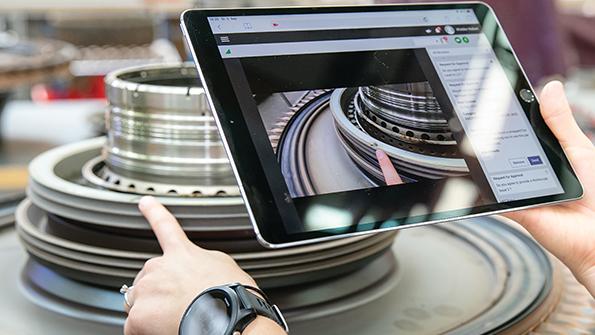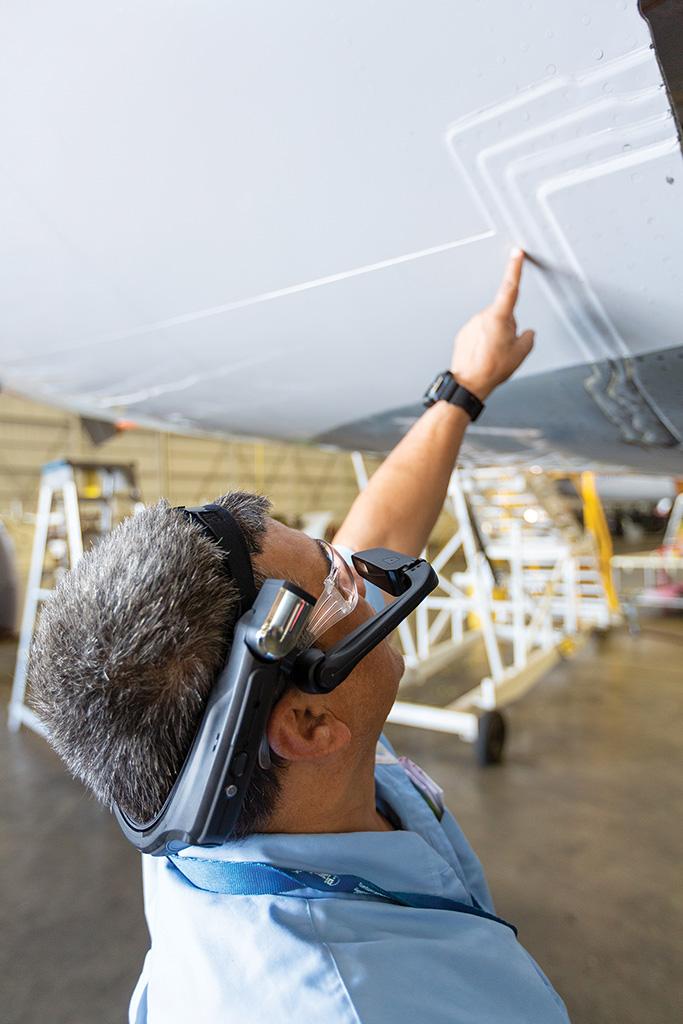
The world has become accustomed to conducting business in a virtual environment due to the COVID-19 pandemic; but for the MRO industry—which requires manual work in a shop or hangar—the situation has posed extra challenges. Technicians still need to stay socially distant, and international travel restrictions have placed heavy limitations on the ability of experts or inspectors to travel to customer sites.
Prior to the pandemic, many airlines and MROs were beginning to test or adopt emerging technologies such as paperless software, wearables and automated aircraft inspections, but change was happening slowly. However, pandemic constraints have forced the industry to embrace new technologies and accelerate their adoption as a way to keep business running.
REMOTE INSPECTIONS
According to Peter Troman, service integration manager at Rolls-Royce, the pandemic has accelerated projects within the engine OEM’s portfolio and brought about new ideas for how to use its existing digital capabilities. One digital collaboration tool that was already in its toolbox pre-pandemic was Librestream Onsight Connect, which enables workers in the field to securely share live videos and images with remote experts across mobile and Wi-Fi networks.

“Pre-pandemic we were using this tool, but it was very much in a sort of break-the-glass situation where people in the field needed additional support on a fairly ad hoc basis,” says Troman. “Once lockdown happened, we could no longer travel to support our customers, and we were at the point of a number of our customers going AOG [aircraft on ground] because we couldn’t fly in inspectors to perform specialist Trent 1000 inspections.”
Now, Rolls-Royce is using Libre-stream to train airline engineers to remotely carry out complex tasks such as checking the condition of Trent 1000 IP compressor blades. Using the technology, trainers are able to demonstrate the task before trainees perform it themselves, sharing images from a borescope and an oscilloscope screen to confirm that the probe is in the right place and that the equipment is being used correctly.
Troman says the practice has already averted a number of AOG incidents and saved customers “a considerable amount of time and money,” such as a situation with Air China that he notes was the catalyst for offering this remote training in the first place. The airline had seven engines that needed to be inspected and was planning to remove them and physically truck them 1,300 mi. to Hong Kong, where the nearest inspectors were located. “This would have been a huge disruption to the airline and very expensive and time-consuming. The use of Libre-stream definitely helped Air China to avoid that,” says Troman.
Like Rolls-Royce, AAR had already invested in Librestream’s augmented reality platform alongside RealWear HMT-1 headsets to test out whether the technology could improve efficiencies. Brian Sartain, senior vice president for repair and engineering services at AAR, says the remote--collaboration capabilities of both technologies have now been adopted as a way to effectively social distance.
“We’ve done some testing with that same wearable technology to limit the amount of time a person—let’s say an engineer who might be working from home—has to actually come onto the floor and into a facility,” he says. “A hangar being an essential workplace and the way that the work is done there, a majority of the employees are still coming to work, but [for] those who can’t or have special conditions, we’re encouraging them to stay home and then we can use all of the technology that we have available to us.”
In addition to using the technology for in-house collaboration, AAR is leveraging the technology for conducting audits with the FAA. “The FAA is telling us what they want to audit and what they want to look at, and we’re actually taking them through a virtual audit so they don’t have to come on-site,” he says.
The use of remote video for regulatory inspections and audits is also being leveraged at MRO Holdings, which earlier this year used a video conferencing system on a mobile device to facilitate a walk-through of an entire repair station to gain regulatory approval for a facility expansion. Gregg Brown, vice president of compliance and technical solutions at MRO Holdings, says the technology functioned as the “eyes and ears for the inspector” during a walk-through of the facility, enabling them to see everything they would normally inspect and to receive even more digital evidence than would normally have been obtained.
“It allowed for a timely approval for the facility to be in use immediately afterwards,” says Brown. “From a timing perspective it had the potential, for a capex-intensive project, to sit idle for months—if not longer. But instead, it’s now already being used as it was intended, so it was a great outcome.”
Magnetic MRO, which introduced virtual inspections this year in response to the pandemic, says feedback from customers has been positive, particularly since the technology has enabled work to be performed in less time and with lower costs during the crisis. Tonno Toompuu, engineering manager at Magnetic MRO, says demand is only increasing for inspection services due to more frequent fleet changes. However, some in the industry still lean toward traditional methods.
“In some cases, physical on-site inspections are still the preferred way to go and virtual inspections are considered as a last resort. However, in my opinion, virtual inspections can absolutely be part of the aviation world’s future,” says Toompuu. “It should not be considered as a substitute for the physical inspections we are accustomed to, rather as an additional option and tool in supporting the industry’s ever-changing needs and challenges. Certain inspections, like prepurchase inspections, for example, could move into the virtual realm.”
AUTOMATED INSPECTION DATA
Prior to the pandemic, AAR was testing the use of Donecle drones for making visual inspections of aircraft more efficient. The drones can take between 1,500-1,900 pictures per narrowbody aircraft, which can be sent to FAA inspectors as part of the certification process for the technology.
Josselin Bequet, CEO and co-founder of Donecle, says this remote data sharing with external parties is a benefit that has become extremely advantageous during the pandemic. “MROs or airlines, during a routine inspection, have to send a finding to OEMs, and usually it’s a paper report with some images attached. It’s fairly cumbersome and not always time-efficient,” he says. “The ability to very easily produce a digital report from the drone inspection enables them to be much more efficient in that regard.”
Bequet says the functionality is also beneficial for aircraft handovers or transitions, since airlines or operators would typically need to send a consultant on-site to inspect the aircraft. “Obviously in recent months this hasn’t been possible, and most operators have been limited in terms of crew they can send, when it can send them and where they can send them,” he says. “So the ability to have a facility scan the aircraft and then send a full 3D digital picture of that aircraft at a given moment in time [has] really enabled them to speed up that process.”
Nondestructive testing (NDT) specialist IMITec GmbH, which has been developing a remote-controlled aircraft inspection device planned for market release this month, notes that travel restrictions highlight the benefits of this technology. “To travel abroad is very difficult, even for maintenance personnel like NDT inspectors,” says Christian Duerager, managing director at IMITec.
He says IMITec recently received a request from a European low-cost airline to demonstrate the device on one of their aircraft. Since the airline has no internal NDT capability, it had to contract this testing out and fly in an NDT inspector—which is not only costly but a major challenge due to COVID-19 travel restrictions. Duerager says the airline would currently have to allow for NDT inspectors quarantining for 10 days when entering and leaving the country. “That’s an absolute nightmare for the airline,” he adds, noting that a remote-inspection device that can be sent abroad would avoid this red tape.
DIGITAL DATA TOOLS
In addition to seeing more traction for automated aircraft inspection technologies during the pandemic, Bequet notes that he is seeing a push toward more digital MRO processes in general. “We’re seeing a lot of interest from other operators, airlines and MROs who have sort of been forced to move forward because of the pandemic in terms of moving away from paperless processes [and] moving to things like digital signatures, digital sign-off and people, inspectors or experts having to work remotely and provide their opinion on aircraft conditions [without] being on-site,” he says.
Previously, notes Bequet, many airlines and MROs were still focused on keeping data hosted locally. “A lot of people out there are starting to move to cloud-based environments and other solutions to be able to share data more efficiently, especially when their employees aren’t necessarily on-site or [are] in different locations,” he says.

At Airbus, a growing number of customer fleet challenges during the pandemic have been the catalyst for introducing new capabilities to its Skywise data platform. “The COVID-19 crisis highlighted the relevance of digital solutions to provide airlines with ever more efficient means to manage fleet performance in real time and in a tailored manner—helping airlines to make the most of their sometimes reduced or constrained resources,” says Valerie Manning, senior vice president for customer support at Airbus.
The OEM introduced a new Parking Management App for Skywise, which Manning says enables customers to “administer their fleet in terms of aircraft location, maintenance needs and storage procedures by ‘tagging’ their grounded aircraft in Skywise” and virtually parking them in various locations at airports and stations, such as in hangars, at gates or on taxiways. “They can then quickly pull contextual data such as the aircraft’s age, latest and next checks, last major assembly overhaul and more,” she says.
To further help airlines make the most of aircraft downtime during the unprecedented situation, Airbus deployed additional capabilities for its Skywise Reliability offering for automating reliability reporting. It can help airlines identify and prioritize technical issues across their fleets, offering up the most relevant service bulletins and maintenance tasks that could be performed during aircraft downtime.
VIRTUAL TRAINING
Airbus is also leveraging digital technology to provide training to customers during the pandemic. “Among our first actions was to organize webinars with customers worldwide to help them through some of the basic parking and storage procedures, provide [the] first work-alleviation recommendations and to take inputs and requests,” notes Manning. “We held dozens of webinars; in each session, between 100-150 customers were connected, and their feedback was generally very positive.”
In the wake of travel restrictions, the OEM’s Training Services unit also set up and obtained European Union Aviation Safety Agency (EASA) approval for a synchronous distance learning solution for instructor-led maintenance courses that normally take place in a classroom. The solution enabled customers to perform theoretical training locally, led by an Airbus instructor at a remote location. Its field service teams then acted as “training invigilators” to support on-site training examinations worldwide. By September, it had delivered more than 65 synchronous distance-learning courses to more than 546 mechanics, and Airbus says feedback has been very positive.
At 8tree, which provides 3D aircraft inspection tools, existing virtual demonstration processes have been adapted to onboard new customers and provide online training. What was previously a two-day, in-depth training class at a customer site has been transformed into a personalized online classroom for a small number of trainees. “I think there are always going to be a few bumps along the way as we adapt the curriculum and delivery of it, but so far feedback from customers has been very positive and we feel very encouraged about that,” says Arun Chhabra, co-founder and CEO of 8tree. “Customers really sort of fall off their seats when they see that all of this can be done without the tool ever leaving them and without anyone coming on-site, and so to us that really is a big enabler to customer satisfaction.” Post-pandemic, Chhabra believes that this model “may pave the path to much more efficient customer interaction.”
Magnetic MRO recently received EASA Part 147 approval for online training, and it is now offering Airbus A320 and Boeing 737 type training online. “This was just a natural step in the current situation, as it provides the option to continue rather than postpone the education,” says Toompuu. “More and more people are expressing interest toward such training, so we are working on providing additional courses and new dates to accommodate growing demand.”
Moving forward, Toompuu expects the pandemic to be a driver for the MRO industry’s acceptance and usage of new technology. “In prepandemic times, in some cases the industry was running on ‘that’s how we always do it,’ but times like these require a new approach—and now this approach becomes not even the ‘new normal,’ but just ‘normal,’” he says.
At Rolls-Royce, which recently delivered its first remote training course to an overhaul shop on how to use specialist tooling to dress the leading edge of fan blades, the benefits of adopting technology are outweighing reluctance to embrace new ways of working. “I think we’ve seen a huge acceleration of the adoption of technology. What the pandemic has done is broken down those barriers,” says Troman. “I just don’t think we’ll revert back to the old ways of working, and I’m already seeing requests from MROs and the customers on other tasks we can train remotely.”

